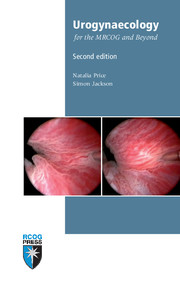Book contents
- Frontmatter
- Contents
- Preface
- Abbreviations
- 1 Applied anatomy and physiology of the lower urinary tract
- 2 Definition and prevalence of urinary incontinence
- 3 Initial assessment of lower urinary tract symptoms
- 4 Further investigation of lower urinary tract symptoms
- 5 Management of stress urinary incontinence
- 6 Management of overactive bladder syndrome
- 7 Recurrent urinary tract infection
- 8 Haematuria
- 9 Painful bladder syndrome and interstitial cystitis
- 10 Pregnancy and the renal tract
- 11 Ageing and urogenital symptoms
- 12 Fistulae and urinary tract injuries
- 13 Pelvic organ prolapse
- 14 Colorectal disorders
- 15 Obstetric anal sphincter injuries
- Index
1 - Applied anatomy and physiology of the lower urinary tract
Published online by Cambridge University Press: 05 July 2014
- Frontmatter
- Contents
- Preface
- Abbreviations
- 1 Applied anatomy and physiology of the lower urinary tract
- 2 Definition and prevalence of urinary incontinence
- 3 Initial assessment of lower urinary tract symptoms
- 4 Further investigation of lower urinary tract symptoms
- 5 Management of stress urinary incontinence
- 6 Management of overactive bladder syndrome
- 7 Recurrent urinary tract infection
- 8 Haematuria
- 9 Painful bladder syndrome and interstitial cystitis
- 10 Pregnancy and the renal tract
- 11 Ageing and urogenital symptoms
- 12 Fistulae and urinary tract injuries
- 13 Pelvic organ prolapse
- 14 Colorectal disorders
- 15 Obstetric anal sphincter injuries
- Index
Summary
A detailed description of formal anatomy is beyond the scope of this text and of limited interest to the general clinician. There are, however, certain aspects of anatomy that are of particular clinical relevance and should be familiar to everyone working within this field.
Normal lower urinary tract function depends, during the filling phase of the cycle, on adequate bladder capacity, bladder compliance and a competent urethral sphincter. The voiding phase is dependent on detrusor contractility and coordinated urethral relaxation.
The bladder
The bladder has to be highly compliant to enable urine storage without significant rises in intravesical pressure. The extracellular matrix of elastin, collagen and intercellular ground substance determines much of the bladder's viscoelastic properties. In addition, the bladder wall consists of smooth muscle bundles. As the detrusor muscle has an outer longitudinal layer and inner oblique and circular layers, it can be divided into the more distensible dome (Figure 1.1a) and a thicker, less distensible base. The mucosal lining has to provide protection from constant contact with urine and it is composed of a highly specialised transitional epithelium. The urinary trigone has its apices at the ureteric orifices (Figure 1.1b) and the internal urinary meatus. The ureters pass obliquely through the muscle wall of the bladder and this prevents vesicoureteric reflux of urine. The innervation of the bladder is predominantly autonomic: the parasympathetics stimulate detrusor contractility while the sympathetics maintain urethral sphincter tone.
- Type
- Chapter
- Information
- Urogynaecology for the MRCOG and Beyond , pp. 1 - 4Publisher: Cambridge University PressPrint publication year: 2012

